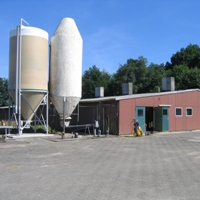Research into pig farm emissions

Anyone downwind of a pig barn knows that animal production facilities generate some notable emissions. Now Agricultural Research Service (ARS) scientists have conducted research into how the location and placement of buildings and waste-storage facilities affects the transport of odour constituents like ammonia and hydrogen sulphide.
Preliminary findings from the wind tunnel studies indicate that positioning farm buildings perpendicular to prevailing winds could help reduce odours from downwind lagoons or tanks.
Influencing factors
Influencing factors
Wind speed and direction, topography, structures, facility management, climate and vegetative cover all influence airflow–and influence where these agricultural emissions end up.
ARS scientists Tom Sauer and Jerry Hatfield are using a wind tunnel to model how air emissions from animal production facilities travel across the landscape. The scientists, who both work at the ARS National Soil Tilth Laboratory in Ames, Iowa, used a 40-foot wind tunnel for their research.
The “wind†was produced by a blower at one end of the tunnel that generated maximum wind speeds of 30 miles per hour.
Test “farm”
Sauer and Hatfield built a test “farm†in the wind tunnel that had scale replications of swine finishing units, aboveground slurry tanks and lagoons. They arranged four of these model buildings on their “farm†in several different configurations with the model storage tanks.
ARS is a scientific research agency of the U.S. Department of Agriculture.
Related Website
ARS
Click here for the free Pig Progress newsletter
ARS scientists Tom Sauer and Jerry Hatfield are using a wind tunnel to model how air emissions from animal production facilities travel across the landscape. The scientists, who both work at the ARS National Soil Tilth Laboratory in Ames, Iowa, used a 40-foot wind tunnel for their research.
The “wind†was produced by a blower at one end of the tunnel that generated maximum wind speeds of 30 miles per hour.
Test “farm”
Sauer and Hatfield built a test “farm†in the wind tunnel that had scale replications of swine finishing units, aboveground slurry tanks and lagoons. They arranged four of these model buildings on their “farm†in several different configurations with the model storage tanks.
ARS is a scientific research agency of the U.S. Department of Agriculture.
Related Website
ARS
Click here for the free Pig Progress newsletter











